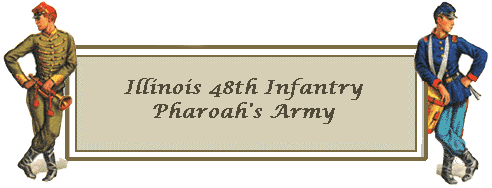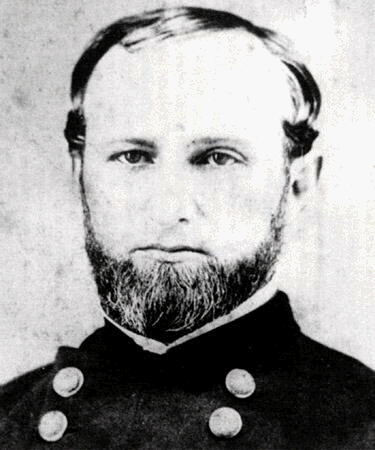

submitted by David A, Stumpf, M.D., Ph.D.
540 Judson Avenue, Evanston, Illinois 60202-3084
847-475-7589

HAYNIE, Isham Nicholas
Born: November 18 1824, Dover, Tennessee
Died: May 22 1868, Springfield, Illinois
Pre-War Profession: Farm laborer, lawyer, Mexican war, politician, judge.
War Service: November 1861 recruited 48th Illinois - Col., Columbus KY, Fts Henry and Donelson, Shiloh (w), November 1862 appointed Brig. Gen. of Volunteers - lapsed March 1863, commanded 1st Bde/3rd Divn/XVII Corps in Vicksburg campaign, resigned March 1863.
Post War Career: Lawyer, adjutant general of Illinois.
A descendent, Mark Funk, 6526 18th Ave. NE, Seattle, WA. 98115; 1-206-522-7972 sent the following: "My father for many years had told me that one of my distant relatives was at Lincoln's bedside after the assassination. And there, on page 593 of David Donald's wonderful biography of Lincoln, was the name Maj. Gen. I. N. Haynie."
Here's Mark's biography of the General:
"It was late afternoon, around 5 p.m., when Abraham Lincoln spotted Illinois Gov. Richard Oglesby and the state's adjutant general, Isham N. Haynie, walking across the White House lawn toward the Treasury Building. "Come back, boys, come back," shouted the President, who was returning from a carriage ride with his wife. His old Springfield friends were escorted into a reception room where, for more than an hour, Lincoln entertained them with readings from The Nasby Papers, a book of contemporary political satire.Finally, Mark writes: "Finally, Lincoln was summoned to dinner and bid Oglesby and Haynie good evening. (1)
Within hours, the President would be mortally wounded, cut down by an assassin's bullet at Ford's Theater.
Isham Nicholas Haynie, organizer of the 48th Illinois Volunteer Infantry, warrants somewhat more than a footnote in the history of southern Illinois and the Civil War. Circumstance placed him at Lincoln's side in the hours before the President was killed. Yet he was in the White House that day because of life-long political ambition, alliances and friendships with such important figures as Gen. John A. "Black Jack" Logan, and military service that furthered his political goals.
Haynie was born November 18, 1824 near Dover, Tennessee, which, ironically, would be where his regiment, the 48th, was blooded at the battle of Fort Donelson. In 1830 he came with his parents to Marion County, Ill. (2), receiving little formal education and working as a farm laborer in order to accumulate the means to study law. Haynie was admitted to the bar in 1846, but quickly set aside his nascent legal career to fight in the Mexican-American War. (3)
While Haynie's war record as a first lieutenant in Company C, Sixth Illinois Volunteers is unknown, it likely set the stage for his first election to public office. After the veteran returned to his Marion County home, constituents sent him to the state Legislature in 1850. His term of office finished, Haynie then enrolled in the University of Louisville Law School, where he graduated with the highest honors in his class in 1853. Four years later, he was appointed judge of the Court of Common Pleas at Cairo, Ill. (4)
Haynie was an active Democrat and his political views almost certainly reflected those of his southern Illinois constituents. In 1856, when Logan rose in the state Legislature to denounce then-Gov. William Bissell's position on slavery as a surrender to abolitionist Republican principles, Haynie told him his speech was well received back home. (5) During the critical elections of 1860, Haynie would be a Democratic presidential elector for The Little Giant, Stephen Douglas. (6)
In the days leading up to the Civil War's outbreak, Haynie would also be a conduit for the political views of Logan, by then a member of Congress. Southern Illinois was rife with southern sympathizers and a grave concern to Unionists who feared the region might secede. Because Logan was arguably the most popular political leader in Egypt, many watched to see whether he would ride North or South. In a letter to Haynie meant for distribution throughout southern Illinois, Logan denounced Lincoln as a Nero, fiddling while the United States burned, but added that the President's election, "deplorable as it may be, affords no justification or excuse for overthrowing the republic." (7)
When war came, Logan and Haynie rode with the North. But they would not ride together. The two of them clashed while recruiting the 31st Illinois Volunteer Regiment, a unit which Logan planned to command with Haynie as his lieutenant colonel. Command meant rank and power, and Logan believed Haynie was plotting to take over leadership of the 31st. (8) In the volunteer army that mustered near Cairo in the later part of 1861, political ambition was barely masked. On any given night, Logan and Haynie might have found themselves in an officers' mess with such political contemporaries as Oglesby, Congressman John McClernand and another veteran of the Mexican-American war, Col. Ulysses S. Grant.
Haynie eventually got his command when he recruited the 48th and was appointed colonel by Governor Richard Yates. And soon after, he led a brigade during a high profile, if militarily inconsequential, fight at the Battle of Fort Donelson, a critical victory for the North which eventually established Federal control over the Tennessee Valley. Shortly before 1 p.m. on the engagementıs first day, McClernand ordered Col. William R. Morrison to take the 17th and 49th Illinois Volunteers, along with the 48th from another brigade, to attack Confederate cannoneers on the Donelsonıs outer trenches.
Just as the attack was to begin, the commander of the 48th rode up to Morrison. Historian Benjamin Cooling Franklin describes the ensuing meeting: "Haynie, a prewar lawyer and sometime member of the legislature ... simply pulled rank on fellow lawyer and legislator Morrison in order to command this select mission. Morrison bowed to the inevitable, and the pair agreed to take the objective together."
Haynie, now commanding the 3rd Brigade of McClernandıs 1st Division, led a sweeping charge in which the units got to within 40 yards of Donelson. But, as Franklin wrote, "parade ground alignment disintegrated in the heavy undergrowth . . . accurate and heavy enemy fire, undisciplined volunteers and the terrain broke apart the Haynie-Morrison assault. It was all over in 15 minutes ..." Franklinıs postscript on what became known as "Haynieıs attack": "(It) accomplished little beyond bloodying raw troops, expending ammunition, and bolstering the morale of the Rebels."(9) The 48th sustained more than 40 men killed or wounded.(10)
In April 1862, at the battle of Shiloh, Haynie was severely wounded when the 48th (11), along with other elements of McClernand's 1st Division, was battered during early fighting on the first day. The Colonel then returned to southern Illinois where he conducted an unsuccessful political campaign to claim Logan's old Congressional seat. A "war" Democrat, Haynie was defeated by Josh Allen, a "peace" Democrat, by fewer than 700 votes out of 12,000 cast. (12)
On Haynie's return to duty, he was assigned to command the 1st Brigade of Logan's 3rd Division of McPherson's XVII Corps in January 1863. During that period, he was appointed brigadier general of volunteers, but the U.S. Senate failed to act upon his nomination and it expired on March 4, 1863. (13) Haynie, still seeking political office, returned to the practice of law and was eventually appointed adjutant general of Illinois.
It was in this capacity that Haynie traveled with Governor Oglesby to the nation's capitol in April, 1865. During their afternoon meeting with Lincoln, the President had urged the two men to join him that evening to see actress Laura Keene perform at the Ford Theater. When Oglesby and Haynie learned of Lincoln's assassination, they rushed to the Petersen house where at 11 p.m. they were admitted to the President's room. They would remain there until his death the next morning. (14)
"The excitement baffles description," Haynie would later write in his diary. (15) "The horrors of last night have no parallel in memory or history. The cabinet all surrounded the dying chief: General Meigs, General Halleck, General Hardie, Colonel Vincent, Rev. Dr. Gurley - all present. The Secretary of War was busy all night preparing and sending dispatches; Surgeon General Barnes holding the President's arm, feeling his pulse; the cabinet seated around, and some standing; Governor Oglesby at the head of the bed, and myself near the door. The President lay with his feet to the west, his head to the east; insensible; in comatose state; never spoke."
Haynie would accompany the body of Abraham Lincoln back to Illinois, part of the delegation appointed by the state. He would also draft the resolutions of the citizens of Illinois who urged the national government to return the fallen leader to his home. (16)
Isham Nicholas Haynie died on May 22, 1868. He was 44 years old. He is buried in Springfield's Oak Ridge Cemetary.
- Reck, W. Emerson: A. Lincoln: His Last 24 Hours, pg. 49-51, and At the Deathbed of Lincoln, letter to the editor, Edwin C. Haynie, Century Magazine (April 1896), pg. 954.
- Marion County and Clinton County History of 1881, pg. 95-96.
- Warner, Ezra J.: Generals in Blue; Lives of the Union Commanders, Baton Rouge, Louisiana State University Press [1964], pg. 222-223.
- Marion County and Clinton County History of 1881, pg. 95-96.
- Jones, James Pickett: Black Jack: John A. Logan and Southern Illinois in the Civil War Era; Southern Illinois University Press [1967], pg. 29.
- Generals in Blue, pg. 222-223.
- Black Jack, pg. 68-69.
- Black Jack, pg. 105.
- Cooling, Benjamin Franklin: Forts Henry and Donelson, The Key to the Confederate Heartland, Knoxville, The University of Tennessee Press, pg. 144-45
- Black Jack, pg. 123.
- McDonough, James Lee: Shiloh - In Hell Before Night; University of Tennessee Press, pg. 227; and, Generals in Blue, pg. 222-223.
- Black Jack, pg. 138.
- Generals in Blue, pg. 222-223.
- At the Deathbed of Lincoln, Century Magazine, pg. 954; and, A. Lincoln: His Last 24 Hours, pg. 49-51.
- At the Deathbed of Lincoln, Century Magazine, pg. 954.
- Ibid.
Finally, I came across a book that I think you will find most fascinating. It is "Black Jack: John A. Logan and Southern Illinois in the Civil War Era." I got it at Barnes and Noble, but is also available from the Southern Illinois University Press, P.O. Box 3697, Carbondale, IL 62902-3697. It chronicles the political ferment that gripped Egypt during the days prior to and during the War. The book also seems to underscore a point I made in one of our first correspondences: That there was considerable political intriguing among those chosen for command. It turns out that Logan and Isham Haynie were regular correspondents, that Haynie helped recruit Logan's 31st Illinois Infantry Regiment and that Logan believed Isham was manouvering to take its command! In some ways, it sounds as though the 31st and 48th could almost have been sister units, with almost all their volunteers coming from the counties comprising Egypt."
Mark's brother has produced a very nice song entitled Pharoh's Army about the 48th.